4 Ways to Duct a Dehumidifier
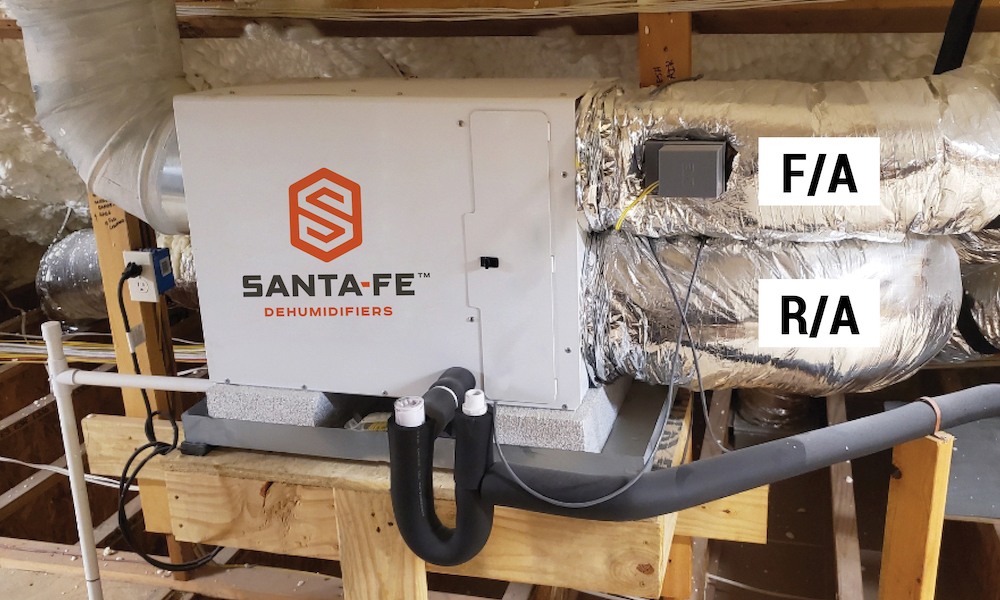
Humidity control is becoming a bigger deal than it used to be. As Joseph Lstiburek, PhD, PE said to me one time, “the gap between stupid and hurt is narrowing.” Building codes and best practices are getting better, which is reducing the drying potential of homes. The result is—or can be—moisture damage in walls, floors, and ceilings. That can lead to expensive repairs, reduced comfort, and indoor air quality problems. That means there are a lot of places where a dehumidifier is practically essential now. So today, I want to go through four ways to duct a dehumidifier, in order of best to worst.
1. Independent ducting
The best way to duct a dehumidifier is to give them their own independent ducts. The intake side is connected a grille (or maybe multiple grilles). The supply side is connected to a grille or register (or maybe more than one). It’s the simplest way to set up a whole-house dehumidifier.

Pros
- Simplest ducting method
- Easier to get the air flow right since there’s only one blower affecting the pressure in the ducts
- Dehumidifier does not need to be near air conditioner.
Cons
- May require more space for ducts
- Because the dehumidified air is warm, you have to find a place to send it where it won’t create comfort problems.
2. Dry air sent into air conditioning ducts
The second best way to duct a whole-house dehumidifier is to send the dry air into the air conditioning ducts. This makes things more complicated because now you have two blowers moving air and creating pressure differences in the ducts. You also have two choices. The dehumidifier intake will have its own grille, but you can put the dehumidified air into either the return or the supply side of the air conditioner.
From the diagram below, you can tell which is the better choice: the supply side. I’ll probably do a whole article on the reasons behind that setup, but for now let me just keep it simple. When you put the dry air into the return side, you’re taking away some of the air conditioner’s job. Normally, the return air going into the air conditioner needs both cooling and dehumidification (sensible and latent cooling) for those of us in humid climates. By putting dehumidified air into the return side, the entering air is drier. The AC does less work, and the dehumidifier does more work. So you end up using more energy and running the dehumidifier more than you would in the better configuration shown below.
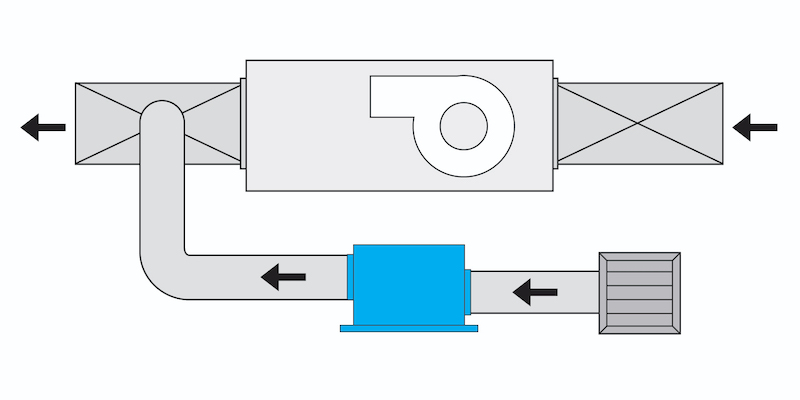
Pros
- Dehumidified air gets tempered with conditioned air before entering the conditioned space.
- Dehumidified air gets distributed throughout the house or zone.
- Can reduce the amount of ducting needed compared to independent ducting
Cons
- May need to increase the supply duct size to handle the additional air flow
- Increased energy use if you put the dehumidified air into the return side
3. Bypass method
In this configuration, the dehumidifier intake pulls air from the return side of the air handler, dehumidifies it, and then sends it into the supply side to mix with the conditioned air. Some of the air bypasses the air handler, hence the name. This method can reduce the amount of ductwork needed.
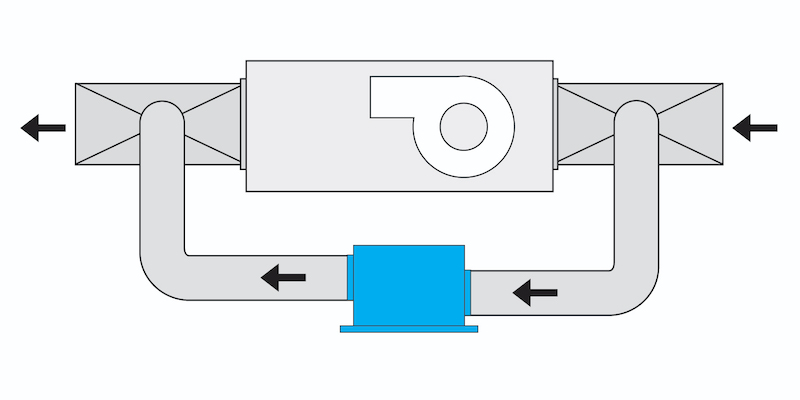
Pros
- Can reduce the amount of ducting needed compared to independent ducting
- Dehumidified air gets tempered with conditioned air before entering the conditioned space.
- Dehumidified air gets distributed throughout the house or zone.
Cons
- Return and supply ducts may need to be increased to handle the additional amount of air flow.
- May need damper to prevent backflow through dehumidifier
- Will need a method to prevent short-circuiting when the air handler is not running. This could be a second damper or having the air handler wired to keep running whenever the dehumidifier runs.
4. Injection Method
The final method here has both the intake and dry air sides of the dehumidifier connected to the same side of the air handler. In the diagram below, they’re connected to the supply side. Putting them on the return side has the same problem of reducing the moisture removal capacity of the air conditioner mentioned in method 2 above.
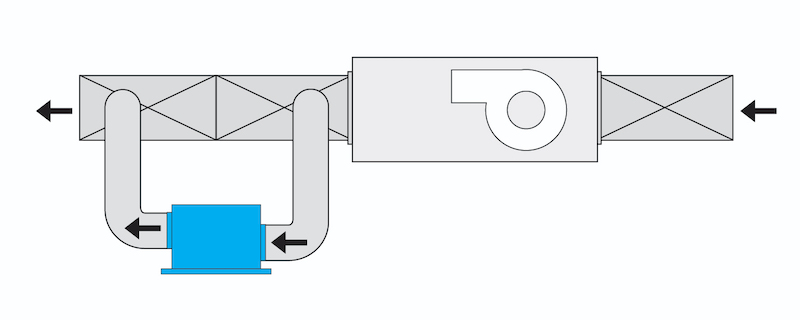
Pros
- Can reduce the amount of ducting needed compared to independent ducting
- Dehumidified air gets tempered with conditioned air before entering the conditioned space.
- Dehumidified air gets distributed throughout the house or zone.
- Can increase dehumidifier efficiency because of cooler entering air
Cons
- Air handler must run whenever dehumidifier runs to prevent short circuiting.
- May need damper to prevent backflow through dehumidifier
- Increased energy use if you put the dehumidifier on the return side
- With dehumidifier on supply side, dehumidifier capacity can be lower because of cooler entering air.
- With dehumidifier on supply side, this method is appropriate only for hot humid climates with lots of air conditioner runtime.
- Not every dehumidifier can handle cooler entering air in supply-side injection method.
Final notes
For simplicity of design and operation, independent ducts are your best choice. Connecting to the air conditioning ducts complicates things because you have two fans moving air and creating pressure differences. You have to consider the relative air flows when you connect two duct systems because you want the dehumidified air flow to be less than the air conditioner air flow. Some of the configurations above also require larger ducts, dampers, and different control methods (i.e., running the air handler whenever the dehumidifier runs).
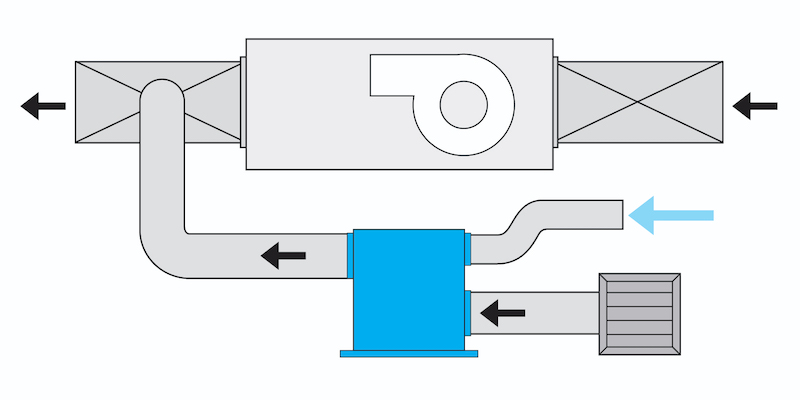
One other ducting issue I didn’t mention above is the ventilating dehumidifier. The lead photo shows one ducted to bring in outdoor air as well as dehumidifying air from the home. The R/A duct (for return air) is the intake for recirculated air from the home. The F/A duct (for fresh air) is bringing in outdoor air. They both go through the dehumidifier and get distributed to the house. You can set up this type of system using any of the four ways to duct a dehumidifier described above. You just have the additional duct bringing in the outdoor air. The diagram above shows a ventilating dehumidifier set up using method 2.
There, that’s not so hard, is it? Of course, we can always make it more difficult. One way to do that is to throw an energy recovery ventilator (ERV) into the mix. Fortunately, David Treleven has covered how to combine heating and cooling, dehumidifier, and ERV ducts in a great article on Green Building Advisor.
And finally, ducting a dehumidifier has the same requirements for good air flow as ducting for heating and cooling systems.
Allison A. Bailes III, PhD is a speaker, writer, building science consultant, and the founder of Energy Vanguard in Decatur, Georgia. He has a doctorate in physics and writes the Energy Vanguard Blog. He also has a book on building science coming out in the fall of 2022. You can follow him on Twitter at @EnergyVanguard.
Related Articles
The Confusing World of Dehumidifier Capacity
17 Steps to Better Duct Systems
An Energy Recovery Ventilator Is NOT a Dehumidifier
Lead photo of Santa Fe dehumidifier courtesy of Nikki Krueger
Comments are moderated. Your comment will not appear below until approved.
This Post Has 21 Comments
Comments are closed.

Hi Allison,
We’ve moved into a new (to us) house in Woodstock. I’ve been using Awair to track indoor conditions, and they aren’t that bad except for elevated humidity levels during the cooling season. We have a new ducted Mitsubishi heat pump with two zones (2.5 tons plus 1 ton), and it can keep summertime humidity in the 60% to 65% range (76 degrees to 78 degrees indoors typically).
The house is leaky enough that wintertime humidity isn’t much of an issue.
During the cooling season, damp towels always have a musty smell. We’ve been considering installing a ventilating dehumidifier. We had an Ultra Aire in a previous home, and it worked well but generated a lot of noise. A desiccant-based dehumidifier would be quieter but maybe it’s not a good choice for our hot humid climate. What do you think?
Does that Mitsubishi system have a “dry” mode? My understanding is that some of them do, but all it does is lower the temperature setpoint.
The small zone has a dry mode. I need to look at the service menu on the larger zone to see if it includes dry as well. (It probably does.) Based on past experience, dry modes aren’t really a substitute for dedicated dehumidification. It helps during the shoulder season, but not when the really hot and humid air settles in.
I agree that the first configuration (independent duct system) is probably the best. As for the other arrangements, it is not as clear to me as what the impact is on overall energy consumption. There is usually a tradeoff between the main AC system efficiency and the dehumidifier efficiency. Do you have any analyses or field studies that quantify those tradeoffs?
I agree with your comments that 50% RH should not necessarily be considered the target for dehumidification. I have seen some studies that show controlling indoor RH to 50% in a humid climate requires significantly more energy than controlling it to 60%.
Roy: Ken Gehring from Therma-Stor gave a presentation in 2016 on the difference between putting the dehumidified air into the return versus putting it into the supply. Here’s the link to his slides:
https://www.buildingscience.com/sites/default/files/07_lazy_air_conditioning_ken_gehring.pdf
He doesn’t provide results of studies, and the slides are a mess because they had a lot of animations that didn’t settle down well. But you should be able to get the gist of it here.
Yea, those slides are tough to decipher. I didn’t really see anything there comparing the overall energy consumption among different installations. I would still like to see some good research to compare the various alternative installation options and how they compare over the entire cooling and dehumidification season in various climates.
FSEC-CR-2038-18 has some good data on energy impacts of different ducted dehumidifier configurations.
I gave that report a quick review and it didn’t appear to be very comprehensive or conclusive as to the best way to connect a whole-house dehumidifier to a central AC system. My conclusion based on this report and other considerations is still that one should just keep the whole-house dehumidifier separate from the central AC system and let it operate independently.
When we consider that allowing humidity levels to rise from 50% to 60% as using less energy, we must consider the total human comfort factor. While maintaining 60% RH reduces energy usage simply by not requiring the refrigeration system to condense the water vapor from the air, 60% RH also causes us to “feel” warmer due to the lessening of the evaporation from our skin to the atmosphere. If one is comfortable at 76 degrees with 50% RH, one is not going to feel as comfortable at the same temperature when the RH has increased to 60%. In which case, one is going to decrease the temperature, wiping out any savings from reduced energy usage from allowing the RH to rise to 60%. We must always keep in mind that while we strive for energy efficiency, we still do what is necessary to make us comfortable. In my over five decades in the HVAC industry, until recently, the average comfort level for average humans is 72 degrees at 40% humidity. By changing the parameters to obtain better efficiency ratings, we only fool ourselves into believing we are achieving more efficient systems.
I have to disagree with Robin. ASHRAE Std. 55 has a comfort envelope that shows for typical summer comfort conditions, a change in RH from 50 to 60% results in slightly less than a 1 F drop in dry-bulb temperature for the same comfort level. I am quite familiar with this chart and it was developed from extensive studies on human subjects in various environmental conditions. I seriously doubt that dropping the temperature setpoint 1 F in a humid climate would result in more additional energy consumption than the energy savings from an increase in RH from 50 to 60%.
Even though anecdotal circumstances are usually considered somehow less important than charts, I will continue to design and set systems for my customers in a way they tell me they are the most comfortable while enjoying reasonable energy costs. We are in the business of comfort. No matter how much we dwell on energy efficiency ratings, we must achieve comfort to have satisfied customers.
How would a balanced air exchanger best fit into the mix when a whole home dehumidifier is involved? Is the dehumidifier ever put on the fresh air side of an air exchanger?
Well done, clear and concise.
Would like to hear your thoughts on the Messana radiant cooling ATU – which is a HRV, Dehumidifier and Fan Coil- similar to what Andrew Ask described in his book H2NO.
I have to add a little bit of a correction/clarification to this paragraph.
“When you put the dry air into the return side, you’re taking away some of the air conditioner’s job. Normally, the return air going into the air conditioner needs both cooling and dehumidification (sensible and latent cooling) for those of us in humid climates. By putting dehumidified air into the return side, the entering air is drier. The AC does less work, and the dehumidifier does more work.”
While it is true that AC systems remove both latent and sensible heat they are not as efficient at removing moisture as a dehumidifier. At the beginning of a cycle they use energy to remove moisture before they use all that energy to cool the air. Also with modern AC units running large coils they are not as good at moisture removal because the coil temp is overall higher than in an older unit with a smaller coil.
Dehumidifiers are set up with a colder coil and low airflow so they will remove moisture efficiently.
Let the AC do the thing it’s best at which is cooling and let the dehumidifier do what it’s best at which is removing moisture.
One advantage to having the dehumidifier ducted into the return plenum is that you can run the feed for the dehumidifier in a part of the house that could really use a return duct. A good way to help even out the temperature of a house if you need a little extra movement around the house. When the unit isn’t running the HVAC unit will still pull air through the dehumidifier and that far end of the house.
Personally I like 35% humidity but that’s pricey and hard to accomplish unless you are in the desert. I’m most comfortable at 35K’ in a tube with dry clean air. Out on the east coast in the GA area it doesn’t get very hot in the summer so I would think that most all houses really need a dehumidifier since the AC won’t be enough to do the job.
Living and working in the Mid-Atlantic region where there is more humidity than the heat load normally addresses, we strive to make cooling systems address latent heat more than sensible. Since doing this greatly reduces the efficiency “ratings”, doing so is not popular with those who dwell only on efficiency “ratings” while neglecting comfort at a reasonable cost of energy.
Utilizing variable speed ECM’s and physically larger indoor coils allows us to maintain the largest area of coil surface at the lowest temperatures to allow cooling systems to address latent heat removal more so while cooling the air. Since cooling system run times are less in lower heat gain areas, having those systems address latent heat as a primary focus greatly decreases RH, allowing us to be comfortable at higher temperatures. We need to focus less on efficiency “ratings” and a lot more on comfort at reasonable costs of energy usage. Robbing Peter (latent load) to pay Paul (sensible load) just to obtain efficient “ratings” is counter productive to obtaining overall comfort.
Airflow perspective: Fans must fight each other if you plumb them both into the supply, (effectively parallel fan setup) where as if you plumb it into the return side, (series fan setup), they effectively “boost” eachother rather than fight for laneway. All depends on if the ducts are large enough to accept the parallel without major loss, would be an issue in many undersized systems, a safer setup is to push into the return and make it easier for the a/c to find air, unless you know how to duct size and add two fan curves as a check. (Parallel adds pressure, series adds cfm)
Fan of the site, keep it up friend
What size dehumidifier is shown as installed as above and what capacity unit is it as to the btu size of the system and the cfm draw and return to the duct system it is providing? I understand it is an air conditioner system that takes supply air into it and through its coil removes humidity and the condenser coil of the unit is providing heat from the unit back into the home air system. Provide the voltage and amperage of the unit. Thanks Larry Manager Airmaker, Inc.
I installed a whole house dehumidifier. It has its own return and connects to the existing ductwork at a plenum going downstairs. There is a gravity damper to prevent backflow into the dehumidifier.
The AC blower is so powerful that it prevents the damper from opening when the dehumidifier also running. Should I (or can I) prevent the dehumidifier from running when the AC blower is running? Is there a way to reconnect the supplies to give the dehumidifier blower a fighting chance to open the damper? I’m wondering if a wye to the existing 12″ duct might be enough.
In my last house I had the same problem the AC fan overpowered the DH fan forcing the damper closed. I solved the problem by placing the duct start collar as near the evaporator coil in the supply plenum as possible. This is point of lowest static pressure because this is where velocity is highest. I further reduced this pressure by build a reverse scoop that basically made a curved wing with the top of the wing pointing into the airflow. Bernoulli did his job and the net result was very little static pressure, no damper shutting during ac fan operation and improved airflow into the system.
You don’t wan to shut the AC fan off during DH operations for two reasons:
1. The AC runs less than the DH when humidity is high during shoulder seasons.
2. When the AC is not running the DH air will try to flow backward thru the evaporation coil causing moisture to evaporate back into the air.
What would be really nice is if someone made some sort of properly designed venture or other device like a scoop that would allow DH air to be injected in the supply stream at a negative stick pressure (suction) point). The final part of the solution would be a computerized control that sequenced all the system AC, vent fan , ERV , DH in a smart (AI) based fashion that learned the optimum comfort strings and maximized efficiency.
Hi,
Where should the supply and return registers for an independent ducting system be located, and why?